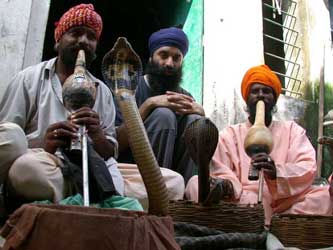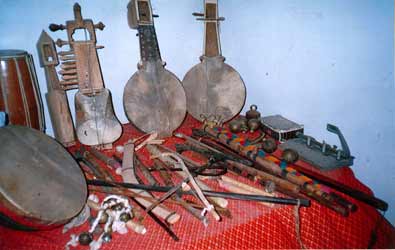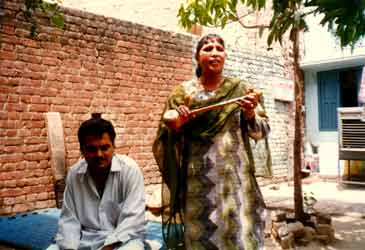   
Get 3 songs FREE
Become
a member Details
Hindi Font
Many pages of this site use a Hindi font. If you don't have it installed on your computer - click here. |
|
|
|
| The real Punjabi music : Himanshu Verma writes on his recent tour to the Punjab in search of inklings of musical traditions |
 Bobby Singh with Sohan Nath and Malkit Singh Beenwalla
(Photo Courtesy: James Ricketson)
Bobby Singh with Sohan Nath and Malkit Singh Beenwalla
(Photo Courtesy: James Ricketson) |
Production assistance for Australian film maker James Ricketson's TV series "Viva: Music in the Blood" for Australian multi-cultural channel SBS, took me on a short trip to Punjab, to meet folk musicians of Punjab. The series traces back Australian musicians to the country of their birth / origin, and we were tracing the roots of Bobby Singh, one of Australia's foremost Tabla players. Bobby, being from Punjab, it was natural that we would allot good time to the exploration of the musical culture of Punjab in the series.
The research itself was exciting, though there is indeed a dearth of research sources for the music and folk traditions of Punjab. |
|
Dr Alka Pande's seminal work "From Mustard Fields to Disco Lights" became my polestar in this small and superficial, but nevertheless exciting effort at looking at the musical traditions of Punjab. The very fact that there is a lack of research material on the music of Punjab, speaks for the state that the traditions of the state are in.
With the ushering in of new ways of life, and the consequent urbanization, liberalization, growth in media like television etc , MTV culture, the remix syndrome, and shortening of the audience's attention span, the folk traditions of countries all over the world (as James' travels all over the world with musicians revealed to him) have suffered a colossal blow. Folk performers are in an utter state of neglect, for want of patronage, audience appreciation. The audiences are no more attracted to the folk forms which once formed a way of life, and an inseparable part of the cultural matrix. Fairs and festivals that provided the musicians with a platform for performance and opportunity for livelihood, and also resulted in sharing of knowledge in a sense, have been on the wane ever since the advent of the urbanization. |
The result being that practitioners of old styles, and masters of rare instruments, have started looking for other sources of livelihood, often at the expense of the art form itself. The hereditary transmission of oral knowledge has been ruptured as the new generation is largely not attracted to these forms, which demand unstinting dedication, and a long training period, and ultimately, in today's scenario offer little hope of providing the basic necessities of life.
|
 Rare Instruments of Punjab
(Photo Courtesy: Alka Pande)
Rare Instruments of Punjab
(Photo Courtesy: Alka Pande) |
|
The state, has been largely indifferent to the cause of the dying arts. There is practically no documentation of folk forms, instruments; and the rich musical tradition of Punjab which broadly consists of classical music, Gurbani (devotional), Sufi music, and folk music; at times seems to be passing into oblivion without so much as a whimper.
But, as our interaction with musicians revealed, not all is bleak. Musicians are indeed determined to preserve tradition, inspite of the attendant hardships. Some young people are learning dedicatedly. And to survive at times, aesthetic compromises are made, by singing with a western orchestra, or over the clutter of electronic instruments, in remixes fashioned for the new generation and the overseas audience.
And popular indeed is the music of Punjab, in however diluted a form, all over the world. As Dr. Pande mentions, "Burgeoning, as the world of Punjabi pop might be, the original, and the real, on the contrary is not half as healthy a state."
Our adventures in Punjab were a testimony to the archetypal hosptilaity of the Punjabis. Often the only contact information we had for a musician was his address, so we would barge in, and announce our arrival, and be treated with food, drink, and music, all served with love.
In Dadumajra, an urban village in Chandigarh, which is home to a lot of musicians especially Dhol players, we went to see Garibdas a popular Dhol player. Well traveled, and successful, he is proud at having passed on his legacy to his son Des Raj, who is further teaching his kids who are about 9 and 11 years old. The three generations gave us a sample of the vast repertoire of rhtymic compositions they had in their bag. Neighbours and passers-by stopped to listen with great curiosity and amusement.
|
 Sufi Dhadi Sharief Idu
(Photo Courtesy: James Ricketson)
Sufi Dhadi Sharief Idu
(Photo Courtesy: James Ricketson) |
We requested Garibdas to contact his friend Mundri Lal, a widely acclaimed toombi and chimta player. Mundri Lal, belongs to the community of Naqqals, or literally 'mimics', and that makes him a rarity. But it so turned out that Garibu was a prima donna and would not meet us even after repeated calls and pleas. He was resting all morning, and then finally said it would take six hours for him to get ready, and don his entire costume. Garibdas told us that there was some truth in that, that Garibu spent hours donning his finery and regalia for performances. We did not hence get an audience with the maestro, pressed as we were for time.
In Chandigarh itself, we traced with great difficulty the veteran performer Sharief Idu, a Sufi Dhadi. Long winding alleys in the medieval fort settlement in the village of Manimajra took us to "Mirasiyon ki Gali", where we finally found him. We were greeted at the door by a stately figure, and he agreed to record for us. Idu sang accompanies by his two sons Vicky and Sukhi. He sang verses from Baba Bulleh Shah, and the epics of Heer Ranjha, and Mirza Sahibaan. His powerful voice entirely gave itself to song, and enraptured us. Endearing indeed were Idu's wise cracks as he sang, at times professing love to his wife who sat with us in the audience, and at times chiding his son for not singing with enough gusto. |
|
We got a chance to witness the closing day of the Chappar ka Mela, a grand fair in Ahmadgarh where musicians from all over come to display their skills. However, that being the last day of the fair, most musicians had left. Nevertheless we got to film some snake charmers and Dhol players beating away to glory at the shrine of Gugga Peer in whose honour the fair is held. Being told of another fair happening at Raigarh, we reached there, only to be told by the authorities that since there had been cases of unwanted drunken revelries, musical events at the fair were curtailed.
In Ludhiana we met the been player Sohan Nath, who belongs to the community of Nath Jogis. He is not to be dismissed as an ordinary snake charmer, for he has a collection of several melodies and compositions to be heard nowhere else. He regaled us with classical and folk tunes. Practically the whole village of snake charmers called Dera Saperian Da, came out to watch the proceedings, and each face was a story in itself. A little girl broke into an impromptu dance, the sheer beauty of which has stayed with me ever since.
25 kilometres out of Ludhiana is the shrine of the Namdharis - Gurudwara Bhaeni Sahib, which is a true example of what an institution can do for the arts. The centre is a virtual storehouse of musicians, and Satguru Jagjit Singh has kept up the old style of Gurbani Kirtan. Several rare instruments like the Rabab, and the peacock shaped Taus have found a home here. There is a practice not to use any keyboards, not even the harmonium here, and the singers are accompanied, as in the old style only by string instruments. Here we had children as young as 10 years old, singing classical compositions with effortless ease and great élan and seasoned performers of the Gurbani kirtan and the various instruments. |
We also met Parween Toombi Walli, one of the few female musicians in Punjab, who floored us with her ease of being, and her lust for life. Though we did not get a chance to hear a performance by this Toombi player, we were all delighted at having met her. James thought she was the sexiest Indian woman he had seen.
Our meetings with these musicians can be called just the tip of the iceberg; the iceberg of Punjab being a vast treasure of house of musical traditions. Not enough attention has been called to the uniquely rich musical heritage of Punjab, with its various forms, styles, expressions and instruments. |
 Parween Toombi Walli
(Photo Courtesy: Alka Pande)
Parween Toombi Walli
(Photo Courtesy: Alka Pande) |
|
|
|
|
|
|
|
|





